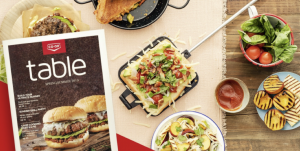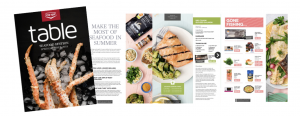Why we launched a print magazine in a digital world
We recently launched a magazine called Co-op Table. This 60-page publication features inspiring recipes — created by some of Western Canada’s top chefs — and engaging content that highlights our store brand products and local producers.

Since launching Co-op Table, a question that keeps coming up is ‘Why would you launch a print magazine in the world of digital? Isn't print a dying media?'
The answer is no. Print media is still relevant even with the rise of digital and in some cases it's more effective. A study of successful campaigns found print advertising is stronger at activating desirability and valuation in the readers’ mind--meaning the reader is more likely to express desire and subconsciously place value on the product when they read the ad in print versus digital. Consumers are also 70% more likely to remember a brand in a print ad versus online.
This makes sense, doesn’t it? Think of all of the distractions when you are engaging with digital content--a text from your mom, a calendar reminder to pick up your kids from soccer, a notification someone liked your Instagram post, and the list goes on. With these disruptions it makes sense that it takes 23% more cognitive effort to process digital media than print.
For these reasons it made sense for us to launch a print magazine that consumers can pick up in our stores and physically interact with. But in our current world, print alone is not enough to effectively achieve our goals. We knew we needed to support the print magazine by developing a complementary digital experience for our customers.
Understanding the reality of digital media and all of the disruptions that come with it, we needed to create digital content that supports the customer’s habits, usage, wants and needs. We needed to make digital disruptive to stand out among the other messages and distractions. The digital content also had to be relevant so consumers wanted to engage with it, and consumable so it can be read quickly before the next disruption pops up.
As a result, we didn’t simply post a PDF of the print magazine online and call it a day. Instead, we created condensed, themed versions of the full publication and included price points on items relevant to the theme. Each themed-issue ran online for 3 to 4 weeks and linked to the full 60-page digital publication for more inspiration.
We made these magazines disruptive in terms of how they look and feel compared to the other flyers/publications hosted online. They were also consumable in terms of their size (6 to 10 pages) and relevant with the added savings to support the theme. The print and digital experiences were then supported through social media, in-store and outdoor advertising.

So what were the results? We’re half-way through the campaign with 60% of surveyed customers indicating they have read the magazine in its print form, 28% read the online version and 12% read both. The digital magazine impressions are already up 300% with engagements up 85% over the previous year’s strategy (16-page booklet flyer). Furthermore, 80% of the readers are new consumers who do not currently engage with our Co-op flyer. So we are driving new customers to our stores with the digital strategy.
So why did we launch a print magazine in the world of digital? Because depending on your goals print can be very effective to connect with consumers. What is important to remember is print and digital are not mutually exclusive. You can effectively accomplish your marketing goals when you view the print and digital experiences as distinctive but complementary to connect with your customers in a way that meets their needs.




